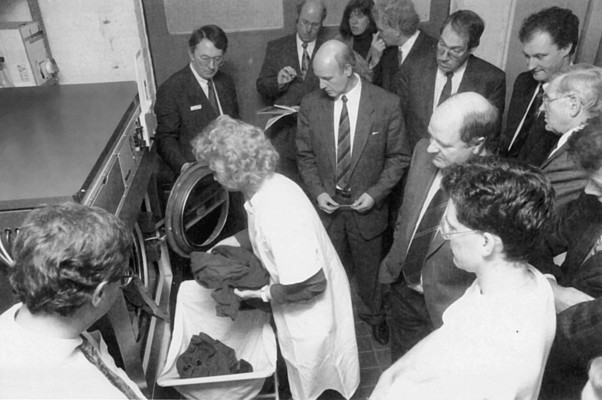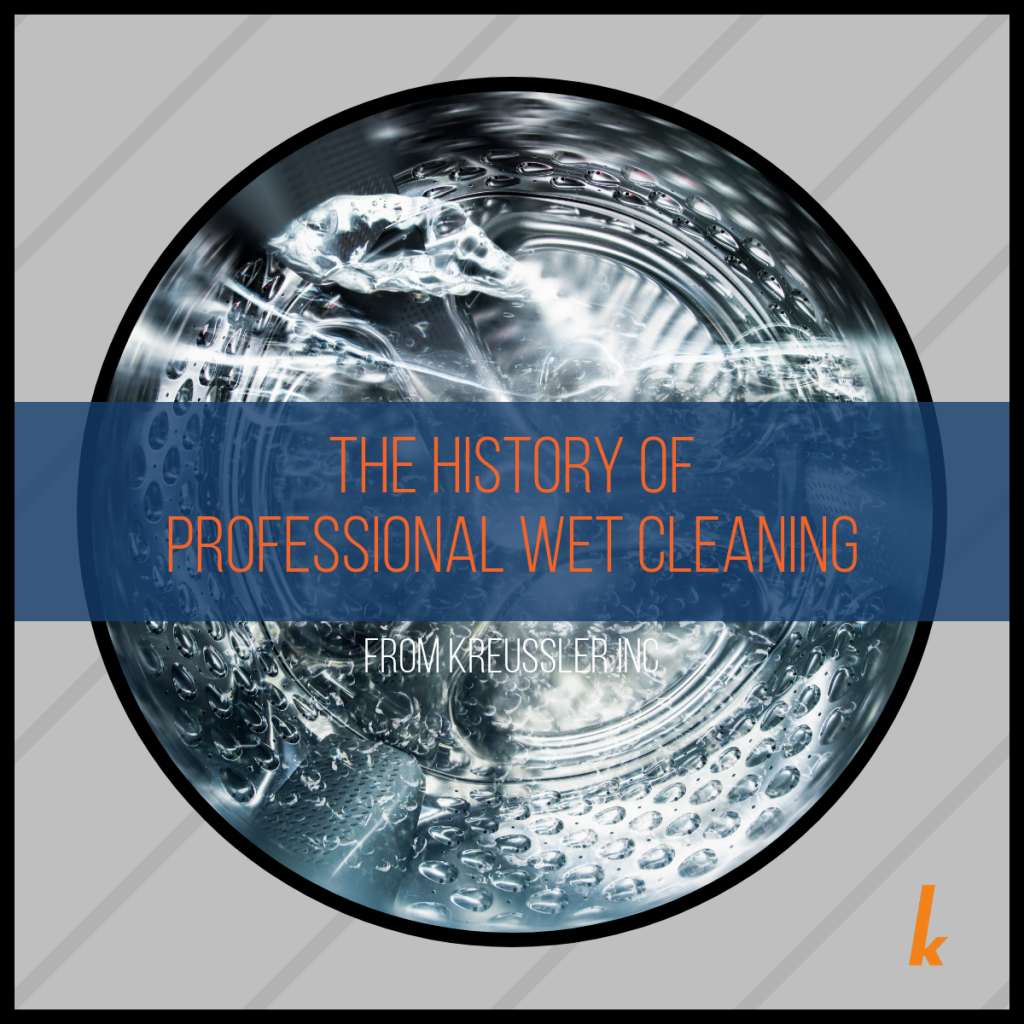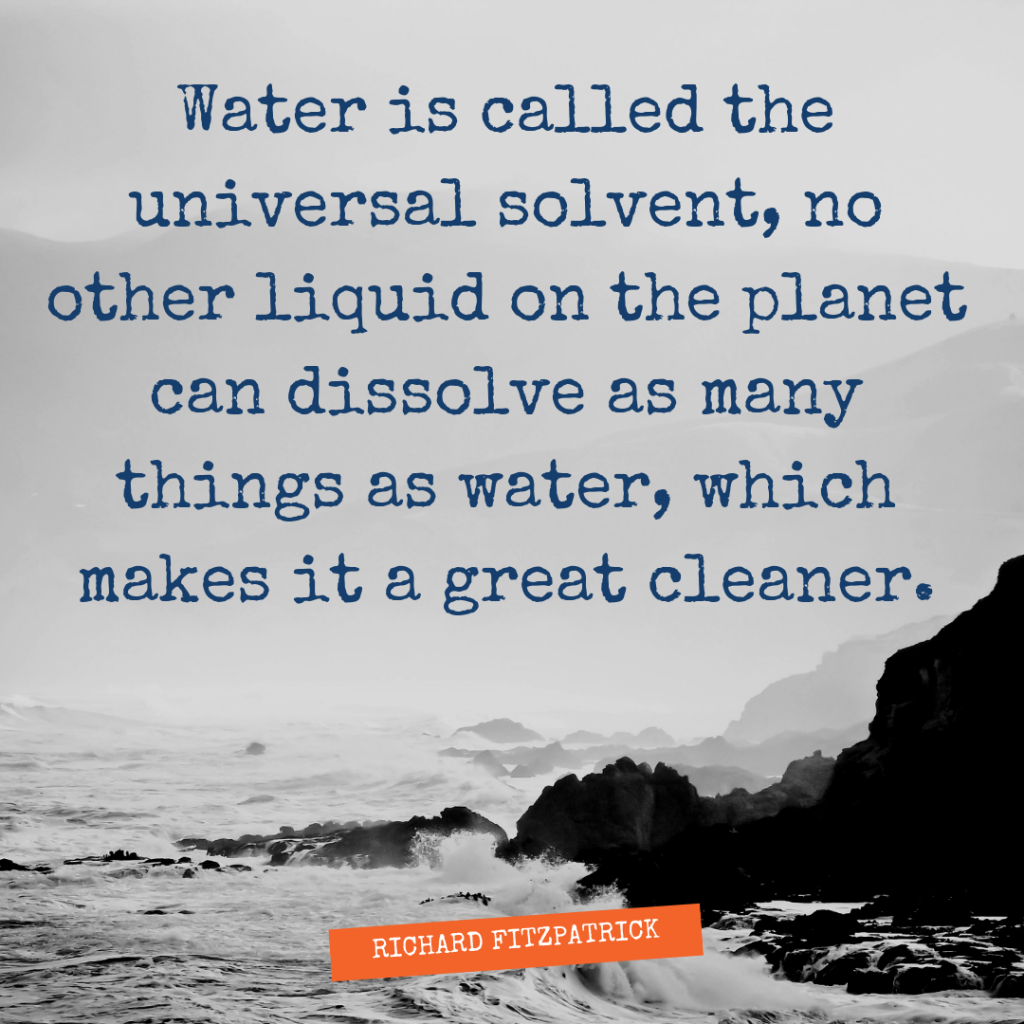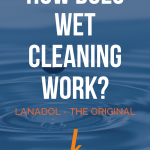For decades, dry cleaners have turned to water for cleaning and restoring textiles that would have been uncleanable in solvents. Of course, washing garments is not new, even the washing of garments not meant to be washed, but this was the exception. Wet cleaning is a unique process that a skilled dry cleaner could turn to when all other options were gone and with the clients understanding of risks and usually with a signed release. This was not a production based process.
In the late 1980’s it became evident to the senior management at Kreussler that the regulations for dry cleaners in Germany would require a dramatic shift in how garments were cleaned. The ability for cleaners to meet the new standards for solvent emissions using the existing technology was impossible. An idea to see if there was a way to use water as the solvent for cleaning “non-washable” garments was presented to our chemists. Could high-risk garments like wool suits and silk blouses, rayon and fine linen be cleaned in the water safely and consistently, over and over and still meet the needs of the client? Twenty-five years of success for Kreussler’s Lanadol line of wet cleaning detergents and conditioning agents has proven a resounding yes. How we got here is an interesting story.
Water is called the universal solvent, no other liquid on the planet can dissolve as many things as water, which makes it a great cleaner. Unfortunately, it is for similar reasons that it has undesirable effects on delicate fabrics like wool, cashmere, silk and other specialty textiles. Even durable fabrics like cotton will wrinkle and distort during the washing process. The physical and chemical characteristics of the fiber, fabrics, finishes, and dyestuff and their interaction with water molecules are to blame.
For example, the vast amount of available hydrogen bonds within the matrix of a wool fiber gives wool its insulating properties, even when it’s damp outside but this also allows for it swell dramatically when wet, increasing the risk for shrinkage and felting. Kreussler first looked to solve the problem of how to immerse wool in water, allow water to dissolve, and carry away soil but restrict the water uptake into the wool itself. In nature wool is coated with a heavy oil excreted by the sheep, making the wool hydrophobic. The same is true for humans; our bodies are producing oils which help to lubricate the skin and coat our own hair.
For our chemists, the first research into washing wool safely was to understand how humans have been washing their hair safely. It should be mentioned that human hair and wool are dramatically different chemically, but the process was close enough to consider the formulations of high-end shampoos as a starting point. What we found is that there are protein collagens that are more attractive to wool then water is, and if it were possible to coat the wool in a mixture of these collagen-based surfactants, it might be possible to provide a temporary barrier for the absorption of water into the wool matrix. Initially, we found protein derived from cow bone to work the best but for anyone remembering the late ’80s early 90’s in Europe will remember mad cow disease. Using bovine-derived collagen became impossible, so we found a new plant-based protein that worked just as well. Testing, testing, testing and yes it was possible to limit the adsorption of water into wool, but that breakthrough on its own was not providing enough inherent safety to process finished garments.
We needed to find a way to:
- Reduce dye migration and prevent fugitive dyes from transferring on to other garments.
- Create a safe pH environment for protein-based fibers; we needed to find a way to dissolve non-polar soil like fat, oil, and grease, the one class of soil water is not good at dissolving on its own.
- Find a safe way to suspend soil in the wash and also an affix a polymer that would provide a smooth, slippery surface to the textile during drying but give the finished garment body and an elastic memory, so it holds its shape.
One by one we tested color fixing agents, dye transfer inhibitors, surfactants and fat eating enzymes, special polymers for conditioning the garments and different emulsifying and suspension agents until the formulations not only provided broad and comprehensive safety and performance but also met the ecological requirements for the German eco-label “ Blue Angel” including to be fully biodegradable, to be free of VOC’s and do not pose a risk for the environment, the staff or clients of the cleaners. We took the step of having all the products independently tested to be dermatologically friendly. Finally, we needed a washer/ extractor explicitly designed for this type of work, with features and controls not seen in the washing and laundry sector.
For the machine design, we reached out to the German company Miele, who was well established as a manufacturer of exceptional quality washing machines. Miele produced a machine which gave the operator full and precise control of all aspects of an application; they also provided a drum with more surface area, smaller drum perforations and specially designed lifters that would gently carry the garments to an exact position and then rain down the water/ detergent mixture on to them. The mechanics of wet cleaning, what the application should look like went through many variations; high water level, low extracts, different temperatures, drum speeds, all things that could be controlled were tested and measured. In the end what we found was that controlling the mechanical influence was best done with absolute low water level, a precisely defined rhythm, and drum speed, and removing as much water as possible at the end of the process. Much of the original applications contradicted general assumptions at the time for “gentle washing.”
For example, it was assumed that a high-water level and high water to garment ratio would allow the textiles to “float” and reduce all types of stresses to the fabric which could cause distortion and shrinkage. What we found was the exact opposite. High water levels first required an excessive amount of detergent to protect the fibers, finishes, and dyes. In addition, a garment floating in water is exposed to constant forces as the water flows into and through the fabric; finally, the cleaning suffered as the soil was left to sit on the fabric without the shearing force of water or friction from other garments to help break it up and carry it away. First what we found was that the detergent and water needed to mix to create what is called a liquor before coming into contact with the garments, and the garments need to be gently rolled in this liquor for a period to allow the collagens to adhere to the fibers. This is done without any significant drop of the garments within the drum. After this wetting process has been completed, then the garments need to be carried up to about the 11:00 position on the drum with enough speed to slightly overshoot the 12:00 position as they drop and land on the bottom of the drum just above the low pool of standing liquor. This allows the garment to compress as it lands and expel a small amount of the liquor and dissolved soil before gently sliding back into the standing pool to soak up more of the detergent/ water mixture and rest for a while. This is repeated for a controlled number of cycles or impulses, providing an exact amount of mechanical energy and eliminating the influence of water.
Countless hours of testing, measuring, adjusting and re-testing went into just this one principle, but that is what it took to know the best way, the safest way and the most consistent way to reliable results. We knew that a client might have a suit cleaned two to three times per month, maybe fifty times per year and expected that suit to last several years. Knowing we could clean it three or five times was not enough.
Miele System Kreussler was launched in 1991 and offered to the German PTC sector as a way to meet the new standards for solvent emission while being able to grow your business and expand your service. It was revolutionary; it was visionary, it was a paradigm shift for the industry. I’m happy to say we received the State of Hessen’s Award of Innovation and multiple patents for our work.

Today, over twenty-five years later our work with Miele in this field is evident in every aspect of Professional Wet cleaning. Every detergent manufacturer that is producing a product capable of cleaning fine wools and silks in water is using formulations based on protein collagens and low pH environments derived from the research and development that Kreussler did. Washing machines today that offer wet cleaning capabilities offer fully controllable computers, inverter driven wash motors on soft mount frames and some even with drums designed with smaller perforations and lower profile lifters much like the original engineering and design done by Miele.
When Kreussler started this project, cleaners had to accept full liability for wet cleaning a “Dry Clean Only” labeled garment as no care label existed. Now we have an ISO label and testing standard for Professional Wet Cleaning, Kreussler participated directly on those working groups to help make that happen. Our trade associations teach wet cleaning as a viable production method for cleaners to use, and machine and chemical providers are regularly hosting seminars to promote the technology. Dedicated 100% Professional Wet Cleaning shops do not outnumber solvent-based cleaners, and Perc is still widely used in Germany, the EU, and the United States, but dry cleaners now accept the fact that almost any garment can be cleaned in water regularly and that for many garments water is the best way to clean it. Nearly every client we have processes a measurable amount of the garments they clean daily in some wet cleaning process and many are looking to increase this number, for the U.S. market much of this change has happened in the last fifteen to twenty years and I think it is safe to say the trend will not turn back to solvents as the only answer for the future of our industry.
Our competitors will argue Kreussler’s role and significance in this development, as is evident by the constant editing of the Wikipedia page on Wet Cleaning and this is fine, this is business. We have the patents and awards, the history, and the story to prove our work in this field and now you know a little more about it.
Selecting a partner, a stakeholder for your company to help you integrate and improve wet cleaning shouldn’t just be based on the company’s history in that technology, look at what Kreussler has done and is doing with this technology. Look at our newest addition to the Lanadol range Lanadol X-Press and the Lanadol Dry process. Talk to someone using Lanadol products about their experiences. Professional wet cleaning is the common denominator for the industry, regardless of other cleaning technologies you may use and endorse every garment care professional should be utilizing wet cleaning and all its benefits. Kreussler can help, and even if you decide to use another chemical provider to maximize this tool, we still celebrate the adoption of the technology we trailblazed and say “you are welcome.”



